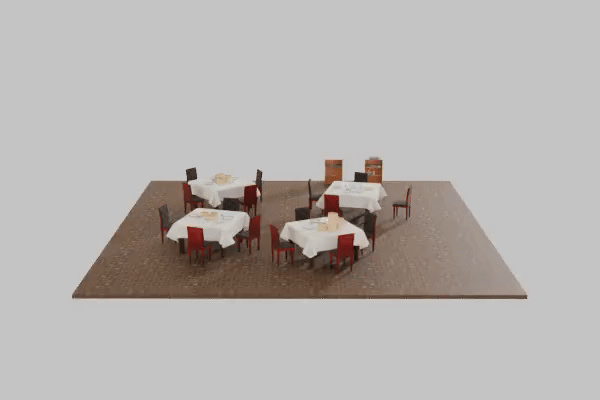Author

Eric Kiplangat
Design & AI
Share Via
MIT CSAIL Revolutionizes Robot Training with AI-Generated Virtual Worlds
How Generative AI Creates Realistic Training Environments for Tomorrow's Robots
Training robots has always been a complex challenge. Traditional methods require countless hours of real-world demonstrations or tedious manual creation of digital environments. Now, researchers at MIT’s Computer Science and Artificial Intelligence Laboratory (MIT CSAIL) have discovered a groundbreaking solution.

Their innovative approach, called “steerable scene generation,” transforms how we prepare robots for real-world tasks. Moreover, this technology promises to accelerate robot development significantly.
Unlike chatbots that learn from billions of text samples, robots need something different. They require visual demonstrations showing exactly how to handle objects. Think of it as teaching through how-to videos.
Currently, engineers face three problematic options:
- Real-world demonstrations: Time-consuming and not perfectly repeatable
- AI simulations: Often fail to reflect actual physics
- Manual creation: Extremely tedious and resource-intensive
Consequently, robot training has remained a major bottleneck in robotics development.
MIT CSAIL's Breakthrough Solution
The research team at MIT CSAIL developed a revolutionary system. This system creates diverse, realistic digital training grounds automatically. Additionally, it uses advanced AI techniques to ensure physical accuracy.
To become home & factory assistants, robots will need to train on lots of demonstrations.
— MIT CSAIL (@MIT_CSAIL) October 9, 2025
MIT & Toyota's GenAI tool creates virtual training grounds to help them inch toward that vision, arranging 3D items into physically realistic kitchens & restaurants: https://t.co/SGlaEly1wo pic.twitter.com/LNnwiMPMjq
The technology was trained on over 44 million 3D rooms. These rooms contain countless models of everyday objects like tables, plates, and utensils. Then, the system intelligently places these assets into new scenes.
The process resembles an artist creating a masterpiece. First, it starts with a blank canvas. Next, it gradually fills in a kitchen or living room with 3D objects. Finally, it arranges everything to match real-world physics.
Importantly, the system prevents common errors. For example, it ensures forks don’t pass through bowls—a frequent glitch called “clipping.”
MIT CSAIL researchers developed three distinct approaches. Each method offers unique advantages for different training scenarios.
1.Monte Carlo Tree Search
This strategy borrows from game-playing AI systems. Specifically, it creates multiple alternative scenes simultaneously. Then, it evaluates each option against specific objectives.
The system can optimize for various goals:
- Maximum physical realism
- Highest number of objects
- Specific task requirements
Remarkably, MCTS achieved impressive results. In one experiment, it placed 34 items on a restaurant table. This far exceeded the 17-object average from training data.
2. Reinforcement Learning Approach
The second method uses trial-and-error learning. Initially, the system trains on standard data. Subsequently, it undergoes additional training with specific rewards.
This approach produces surprising results. Often, it generates scenarios quite different from original training examples. Therefore, robots gain exposure to diverse situations.
3.Direct Text Prompting
The third strategy offers intuitive control. Users simply type descriptions like “a kitchen with four apples and a bowl.”
The accuracy rates are remarkable:
- 98% accuracy for pantry shelf scenes
- 86% accuracy for messy breakfast tables
- 10% improvement over comparable methods
Furthermore, the system can complete partial scenes. Just ask it to “arrange the same objects differently.”
Real-World Applications and Testing
The research team tested their system extensively. They recorded virtual robots performing various household tasks. For instance, robots carefully placed utensils into holders. Additionally, they rearranged bread onto plates across different settings.
Each simulation appeared fluid and realistic. Consequently, this suggests strong potential for training real-world robots.
Industry experts recognize the significance of this research. Jeremy Binagia from Amazon Robotics provided valuable insights. He wasn’t involved in the study but closely follows the field.
“Creating realistic scenes for simulation can be quite challenging,” Binagia explained. Traditional procedural generation produces many scenes quickly. However, these rarely represent real environments accurately.
Meanwhile, manual scene creation requires extensive time and resources. Therefore, steerable scene generation offers a superior alternative.
Rick Cory from Toyota Research Institute also praised the work. He holds advanced degrees from MIT (SM ’08, PhD ’10). Additionally, he specializes in robotics applications.
“This framework provides novel and efficient scene generation at scale,” Cory noted. Furthermore, it generates previously unseen scenarios deemed important for downstream tasks.
He believes combining this framework with vast internet data could unlock important milestones. Specifically, it could enable efficient training for real-world robot deployment.
Meet the MIT CSAIL Research Team
Nicholas Pfaff leads this groundbreaking research. He’s a PhD student in MIT’s Department of Electrical Engineering and Computer Science (EECS). Additionally, he serves as a CSAIL researcher.
“We are the first to apply MCTS to scene generation,” Pfaff explains. The team frames scene generation as sequential decision-making. Consequently, they build progressively better scenes over time.
Key Team Members
The collaborative effort includes several distinguished researchers:
- Russ Tedrake: Toyota Professor at MIT, senior author
- Hongkai Dai: Toyota Research Institute robotics researcher
- Sergey Zakharov: Senior Research Scientist and team lead
- Shun Iwase: Carnegie Mellon University PhD student
The project received support from Amazon and Toyota Research Institute. Moreover, researchers presented their work at the Conference on Robot Learning (CoRL) in September.
Currently, the system represents a proof of concept. However, the team has ambitious plans for expansion. Next, they aim to create entirely new objects and scenes. This would move beyond their current fixed library of assets.
MIT CSAIL has developed another relevant technology called “Scalable Real2Sim.” This system uses images from the internet to create object libraries. Therefore, combining both technologies could produce incredibly realistic scenes.
The team hopes to build a community of users. Together, they would create massive datasets. Subsequently, these datasets could teach robots diverse, dexterous skills.
MIT CSAIL continues pushing boundaries in robotics research. Their steerable scene generation represents just one example. Additionally, the laboratory pursues numerous other groundbreaking projects.

